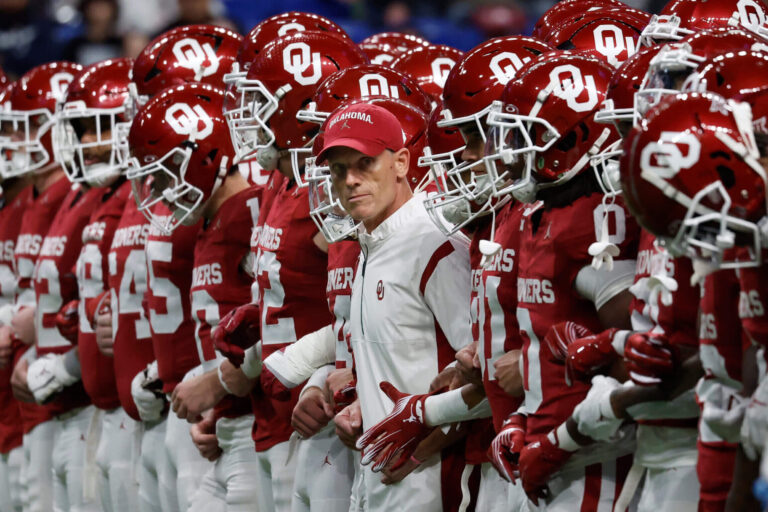The SEC doesn't have divisions anymore – at least until they get down to about 28 teams, and the conferences decide they need divisions again and people say, “Hey, we need divisions again.” “Wait a minute, the Southwest Conference, the SEC in the 1990s, the ACC…?”
What were we saying? Oh yeah, the SEC doesn't have divisions anymore, but old habits die hard sometimes. You may have noticed that last week's mailbag had an SEC East feel to it. Well, this week we're going to go a little further west and stay there and ask another question, and then we'll move on to the conference-wide question.
Note: Submitted questions have been lightly edited for clarity and length.
What are your honest expectations for the University of Oklahoma? Is Brent Venables building something sustainable in Norman? — Asa M.
Oklahoma State is an attractive newcomer to the SEC in that it's a blueblood program that most people don't talk about. The Sooners are in Texas' shadow, but Texas appears to have enough players to compete in the conference. Oklahoma, on the other hand, is 16-10 in Venables' two years there, and has largely limped along with two new coordinators and a new quarterback. The jury is out on Venables as a head coach, and naysayers may wonder if the Sooners are about to morph into Nebraska once they make it to the Big Ten. (As one naysayer answered this question.)

Free daily sports updates delivered straight to your inbox.sign up
Free daily sports updates delivered straight to your inbox.sign up
buy
Still, this is Oklahoma State, a program with much more recent success than Nebraska. The Cornhuskers' last Big 12 championship was his in 1999, and the Sooners won four straight from 2017 to 2020. With a strong administration in place, especially with longtime athletic director Joe Castiglione, it seems unlikely that the leadership will let go of the program. . Venables is also moving in the right direction, going from six wins to 10 wins.
Of course, the SEC is going to be a different animal and this year's schedule looks brutal. When I made my game-by-game predictions a few months ago, Oklahoma finished with him at 7-5 overall and 3-5 in the conference. However, my colleague Stewart Mandel is one of those players who is a little more bullish on the Sooners, coming out of the winter portal period (behind Georgia, Texas, and Ole Miss) and among the top 25 too early. That ranks the Sooners 15th and 6th among SEC teams. , Alabama and Missouri).

even deeper
New SEC: Predictions on what the 2024 season will be like.
Much will depend on how Jackson-Arnold performs as quarterback, but given the schedule and new coordinator, I'm pessimistic about Oklahoma becoming a College Football Playoff contender. is. Long term, I'd be willing to bet that this program can be consistently competitive within the SEC. This is not Nebraska in the recruiting sense, it is geographically isolated and relies on its name. Oklahoma is still close to Texas and has been able to spread its name to other parts of the world. According to the 247Sports Composite, the Sooners have him No. 8 in their 2024 class and, although it's too early, they have him No. 6 in their 2025 class.

Texas Longhorns quarterback Quinn Ewers during spring practice at Frank Denius Practice Field in Austin on March 19 (Brazil/American-Statesman)
Does seeing the elite speed and athleticism of the Texas wide receivers leading up to draft day discount your assessment of Quinn Ewers? A quarterback's success (or failure) depends on the weapons around him, especially the wide receivers. How should we be judged based on that? — George G.
That's something to consider, but I want to point out that in the 2019 LSU offense, Joe Burrow had Justin Jefferson and Ja'Marr Chase, and all three have performed very well in the NFL. (Of course, Burrow and Chase will continue to work together.) Sometimes it's important to have good weapons around the quarterback, and sometimes it's important that all the weapons are really good.
The good thing about Ewers for talent evaluators is that they can now look at him without Ewers and AD Mitchell, just like they can evaluate Georgia's Carson Beck without Brock Bowers and Rad McConkie. I'm saying that. However, both quarterbacks should still have plenty of good receivers, so it is expected that they will continue to put up good numbers.
Still, how quarterbacks apply to the NFL has become far more random. I rely on what they looked like in college and how they played when I saw them play. That's why I thought CJ Stroud was the best quarterback in last year's draft and Michael Penix Jr. was the best quarterback in this year's draft. (I'm a little wary of Caleb Williams for teammate reasons, but that could easily be wrong.) And just because it looks like I was right about Stroud, about Penix. is not necessarily correct. A lot of it has to do with the system the quarterback is in, the players around him, the coaching, and just plain luck. This is the most important position, it's why teams overdraft, and it's the hardest position to predict.
Given Sam Pittman's performance over the past two seasons at the University of Arkansas and the tough season ahead, could he be one of the first coaches to be fired if his record doesn't improve? If so, how does Arkansas look as a coaching landing spot compared to when Pittman replaced Chad Morris? — Marshall J.
Pittman is a professional and like everyone else, he knows his job is on the line this year. When an athletic director has to make a statement that a coach is coming back, everyone understands it's a deal. Pittman deserves credit for making the program respectable again after Morris' failure, but his ultimate record has been trending in the wrong direction over the past two years.
But the end result for Pittman is that by surviving it at 4-8, he could argue that bowl eligibility is a sign that things are heading back in the right direction. I don't know if the University of Arkansas fans or administrators think that way, but there is a path to six wins. Make sure they win three home games and then win the three SEC games plus Oklahoma State. Of course, one of the guaranteed fights is in November, so can Pittman make it that far?
He'll likely need to be bowl-eligible by then, and if not, Arkansas will want to get a head start on the hiring cycle. Given Pittman's high-profile position, a strong start may be needed to avoid things becoming a fait accompli. Here's the first half of the schedule: Texas A&M at Arkansas-Pine Bluff, Oklahoma State, Auburn and Tennessee. If the Razorbacks can get out of their 4-2 deficit, they will have momentum. Anything over 3-3 is dangerous. If it's worse, you might just forget about it.
Given the transfer court decisions of the past several years, how can the SEC's ban on intraconference transfers during the spring transfer window remain a principle (and seemingly unquestionable rule)? — Alex R.
It's hard to understand. If we've learned anything over the past few years, it's that the NCAA loses when it goes to court. But this would be the SEC, not the NCAA. The SEC would argue that it does not prohibit absolute freedom of movement, and therefore the power to acquire name, image, and likeness rights, but only freedom of movement within the conference. It may also depend on the judge's sympathy.
It depends on whether someone tries. Tom Mars, who made a name for himself suing Ole Miss on behalf of Houston Nutt and then going after the NCAA over transfers, has been preoccupied lately with defending Jim Harbaugh. Maybe he'll pursue it once he's free.
But it doesn't seem like there's been an explosion of opposition to this rule like with other rules. This is about the spring period and there is absolutely no question about his ability to move within the SEC. Perhaps there needs to be a specific case that will inspire a lawyer somewhere.

even deeper
SEC Mailbag: How big a deal is Missouri's push? It's chatter season.
Will a reporter talking about what student-athletes consider when choosing a school ever mention college credentials or degrees, or will we be stuck on the NFL/NIL treadmill forever? Will it be? — Joe A.
From what I gather, the academic aspect is just as important as before NIL. However, (1) it may not have been as important as thought at the time, and (2) NIL is new. It's to get more attention.
And many of these athletes go to college for a big reason: to play football. And for many, it's to prepare for the NFL. Only a small percentage of people get there, but it makes sense that they dream of it and make it a priority when they go to college. It's also wise to have a backup plan, and many people do. But how many of you reading this knew what you were going to do when you went to college? I did, and have done so for the past 30 years, but I'm the exception. A lot more people figure that out while in college, and probably a lot of football players do too.
Many programs fail players by not preparing them for life after football. Some players try, but many don't take advantage of it. That is an eternal challenge. As for the NIL, this is peak earning time for many athletes, especially those who don't go to the NFL, so I can't judge those who make that a priority.
If the SEC acquired programs based strictly on the merits of the towns in which they are located (Athens, Oxford, Knoxville, etc.), which towns would best fit the SEC's culture? — Alston B.
There are too many to cut down to. This is coming from someone who lives in a college town, loves it, and has visited many other college towns. Charlottesville, Chapel Hill, Lubbock, Eugene, Ann Arbor… When you say these names in your head, people immediately realize you're talking about college towns (and Tuscaloosa, Auburn, Gainesville, etc.) Masu.
However, it is not possible to precisely categorize what constitutes a city with an “SEC culture.” That includes Austin in particular. There are several buckets.
A small town where university comes first: Athens, Auburn, College Station, Gainesville, Tuscaloosa, Norman, Oxford, Starkville, Columbia (Missouri)
Medium-sized city centered around a university: knoxville, baton rouge
A medium-sized town with a university and more: Columbia, South Carolina (state capital). Lexington, Kentucky (Keeneland); Fayetteville, Arkansas (Walmart)
Fairly large city with mostly universities: austin
Big cities that happen to have universities: nashville
You could also take a bunch of other schools and put them in their own buckets. Before you say, “What, this is an SEC town?” College sports fans share many traits. While each campus may have its own culture and each sports team may have traditions, having a campus sports tradition is unique and thus creates a lot in common for different fan bases .
And that's the beauty of college sports. And that's what we should continue to hold about them. I'm aware of the criticism that college football is turning into a small-scale professional minor league football. What I want is soccer like the English Premier League. It means that even though they are professionals, their fans still feel that attachment, tradition, and emotion. The NFL is the highest level of football in major cities. College football (and basketball) can become a feeder system, paying players while retaining the history, emotion, and everything that makes college football great.
The trick is how to thread the needle.
(Top photo of Brent Venables: Ronald Cortes/Getty Images)

